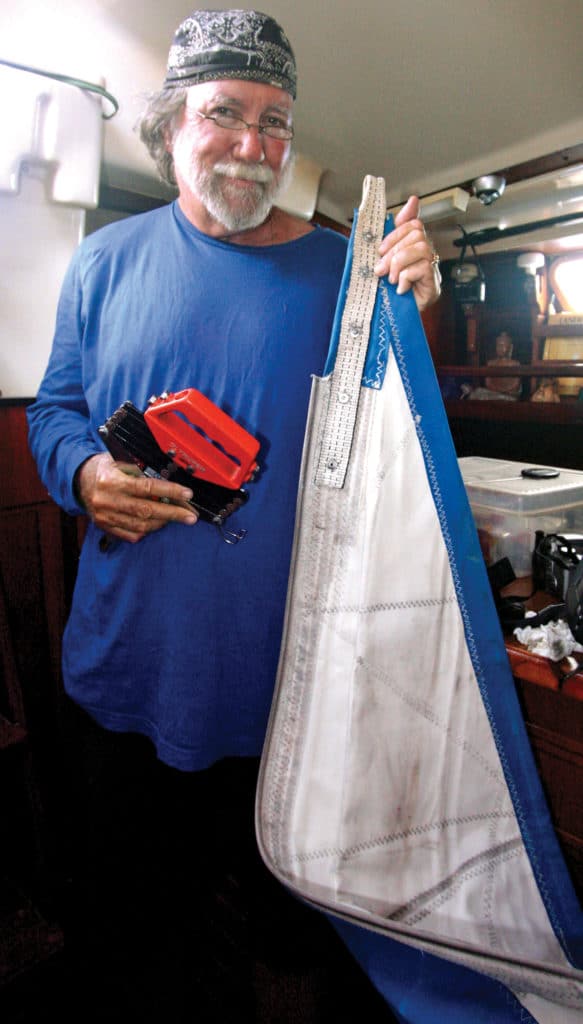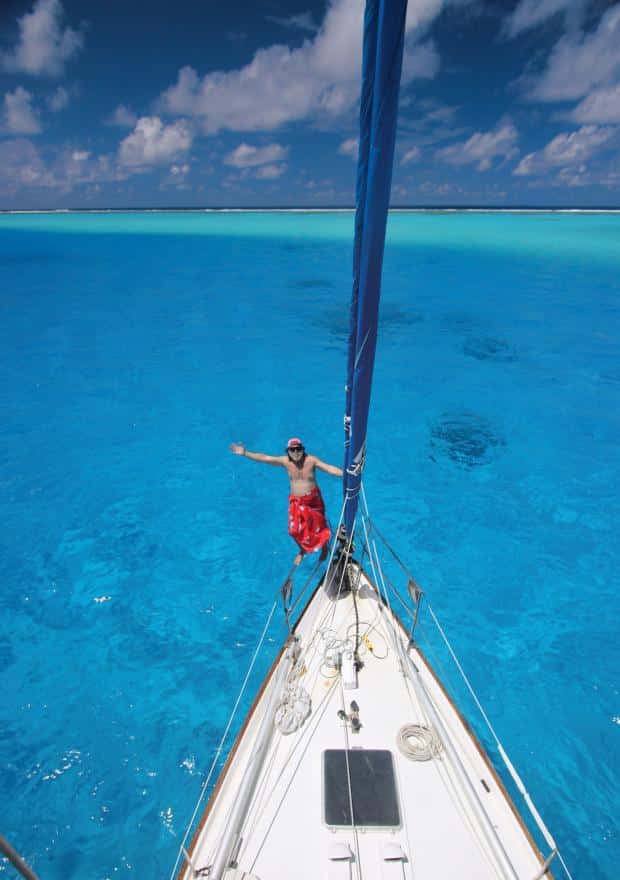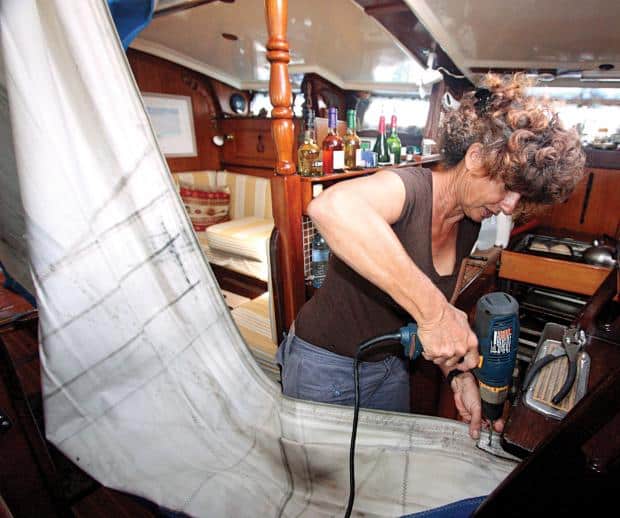
I love to work on my boat with my wife, Carolyn. In fact, fixing up our Wauquiez 43, Ganesh, has been almost as much fun as sailing it across the Pacific.
We do it completely differently than most cruising couples. Our method requires much organization and large amounts of time — neither of which is a problem for us. On the other hand, our approach requires very little money, and we enjoy every second of it.
Consider how we spent one recent month of our lives. We accomplished an amazing number of complex boat jobs, some of which would cost many thousands of dollars in a shipyard. Better yet, while doing so, we earned about $2,000 from writing projects and we spent nothing. I don’t mean nothing extra, I mean nothing on anything, as in zero cents. But best of all, we had one of the most fun, exciting, romantic and fulfilling months of our lives.
Over those few weeks, Carolyn hoisted me aloft to work on our rig many times, and on each occasion, my life was in her hands. Each time I thought, “There is no one in the universe I’d rather have at the end of that rope.”
But I’m getting ahead of myself.
Our recent 48-day passage from the Panama Canal to Tahiti was not the easiest sail we’ve ever experienced. We had a new boat with dozens of untried systems, and we went through a major, prolonged blow (see “Piece of Cake,” On Watch, January 2014). I’d like to report it was a breeze but it wasn’t. Both vessel and crew were tested to their limits, but with a bit of luck, we managed to survive. Ganesh, though, ended up with a useless staysail furler, a torn storm staysail and numerous other less important broken bits. Carolyn had so many black and blue boat-bites that she appeared to be an abused wife.
I decided first to repair us so we could then fix up the boat. I did this by going stern to in downtown Papeete, Tahiti, (expensive) and doing everything possible to make sure my storm-battered wife had a good time. We went out for dinner each evening. We explored the island each afternoon. Mornings were devoted to cultural events. We visited museums, Polynesian exhibits and art galleries. We also attended every fete on the island, without fail.
Every pastry shop owner knew us both by name. We consulted on the evening’s bottle of French wine, even though I no longer partake. (My nose is all the sharper for it, and I can still judge the wine’s sheeting qualities and legs with the best.) Every night we listened to local live music, attended dance performances and studied the local tattoo designs.
Carolyn was in full charge of the social whirl. “Sundowners on Dream Time with Neville and the Pistol Packing Nanny, then dinner aboard the motor yacht Askari with Lon and Rosie. I’m not sure if Doug and Bethanne of Sindbad will be there or not,” she decreed. “Then, if we’re still feeling awake, a nightcap with Bob on that CSY Wind Witch?”Our favorite activity was attending the Sunday farmers market in Papeete. It was an islandwide party, a communal vegetable orgy, so to speak. There was so much laughter, so many smiles, such huge gushes of Polynesian love floating about that my eyes watered with the simple joy of witnessing such universal happiness.
The Polynesians, like the Thais, have much to teach us. I sit at their feet, ever the eager student. Carolyn, how shall I say, noticed. “If I didn’t know better, I’d suspect you are actually trying to be a nice person,” she said at one point, and later noted, “Is it my imagination or are you actually enjoying a nonmarine moment ashore?”
“Life is full of surprises,” I replied.
Throughout all these dirt excursions, I made my long, complicated to-do lists and purchased numerous marine supplies.

Ganesh isn’t a yacht with a crew that’s forced to go ashore in search of an expert when she needs to be fixed, but rather a well-stocked vessel with a commodious tool room and owners who can mend her anywhere. To put it another way, we inventory our 1/4-inch-20 nuts and our #10-32 machine screws and our wood chisels and our epoxy fillers exactly as we do our oil and lube filters, our spare halyards, our emergency rivets.
And given that, why not work on your boat in one of the most delightful, most remote places on this planet?
Beveridge Reef is one of my favorite places in the whole, wide, watery world. It is a landless atoll at 20 degrees S, 167.75 degrees W. There are no people, only wind and sea and sky. Often, whales calve here. It is impossible to dinghy-troll the pass without catching a wahoo. (Oh, what a fight!) The local lobsters have no idea they are tasty. The lagoon is so clear that even while anchored in 40 feet of water, you can clearly see the bottom on a full-moon night. Actually, the water is so clear that at times it’s invisible, and you feel as if your vessel is suspended in mid-air, 40 feet above the perfectly white sand.
There are no distractions, save for God, Mother Nature and King Neptune. The entire Pacific Ocean is your moat. Society seldom intrudes. Occasionally a yacht will wander by on its way to Niue from Rarotonga in the Cook Islands, but the vast majority of days the atoll appears empty, despite the fact that it teems with life just below the surface. The only land is six fathoms down.
As I type this tale, we are anchored within this tiny turquoise-blue and pastel-yellow lake within the bosom of the ocean. We are in a perfect harbor, yet totally dirt-free. There are no cops, creeps or regulations. Thus, we pay particular attention to our wake: We leave absolutely nothing behind but our bubbles, and take nothing with us save photographs. We save every bit of plastic, burn all our paper and crush our tins for later disposal. Our goal is to have zero environmental impact.
It took us 10 leisurely days to sail to Beveridge from Moorea. Since we didn’t have use of our small staysail, we used our larger jib a bit more often than we should have. Our big jib is old and tired and sun-weary. Thus, on the final night at sea, just after midnight, while I unexpectedly happened to be on deck, our jib thonked a dull low note of surrender, and came fluttering down into my outstretched, surprised arms, thanks to the failure of its sun-damaged head-strap webbing.
We sailed into Beveridge headsail-less, and with a long list of boat jobs ranging from the very simple to the most complex. Our next major ocean crossing would be down to New Zealand, and statistically, the most storm-prone passage of most circumnavigations. We wanted Ganesh to be at her best for this heavy-air romp. There are no excuses in a gale, and now was the time to eliminate the need for them.
Once anchored, we soon fell into our normal work routine: rise with the sun, monitor the SSB cruising net during breakfast and work until lunch. Lunch isn’t just about food, it’s the social centerpiece of our day. Afterward, we take a swim and maybe a brief nap. Then it’s back to work on the boat until sundowners in the cockpit at 1700, followed by dinner, reading and sleep. Repeat daily.
Our staysail roller furler was our major problem. Most sensible people would bring their boat to a rigger; have him remove the stay and furler; put the kit on sawhorses ashore; laboriously locate the lost link pin that had fallen between the furler’s foils; replace and reassemble the unit; replace the stainless-steel wire; use new cones in the Sta-Loks; and then hoist the furler back up in place on the mast.
This would cost a pretty penny, “and the few pennies we have aren’t very pretty,” mused Carolyn.
Exactly.
So, I left the whole mess vertically in place on Ganesh and carefully uncoupled the offending foils while working from a bosun’s chair. This required dealing with numerous tiny parts while swinging high above the deck; not an easy task. There was just enough room to stick a tiny wire up and into the foil below where the missing link was. A plumber’s snake would have been ideal, but we didn’t have one. But we did have a number of thin stainless-steel welding rods, which we lashed and taped together to make one 10-foot rod; it was just strong enough to push the link back into its proper place between the foils. This took both of us three full working days, but ultimately we had a completely repaired staysail furler.
Yes, we had all the Loctite and foil screws we needed in inventory, thanks to preplanning and FedEx in Tahiti. Twice I needed a small custom stainless-steel part machined, which I accomplished using our tool room’s vise, grinder, metal file, Dremel tool and micrometer.
The action soon shifted belowdecks. Carolyn hauled out the staysail that was damaged when the furler broke, and her trusty Pfaff sewing machine, as I retired to the aft cabin to sling a sentence or two.
“But the major problem,” she said as she showed me the jagged tear in the sail during lunch, “is we don’t have a roll of Dacron cloth.”
“Oh, don’t be so fussy,” I scolded her. “We have six sail bags, don’t we? What are they made of? And that old moldy hank-on Yankee under the forward head, why not chop that up? Use the Sunbrella in the sail covers, if you must. Or the heavy marine fabric covering the cockpit cushions.”

“But,” she said, “any sailmaker in the world will tell you to use Dacron.”
“Huh?”“Where in the world?”
“Where are the sailmakers of the world generally located?”
“In their sail lofts?” she asked, puzzled.
“Exactly!” I said. “And we are located at sea, where we generally are and really, really love to be. So, if you follow their advice, you spend a lot of time ashore at the ATM, and if you follow my advice, you’ll spend almost no time at either! Hooray! Life’s an intelligence test, and, so far, we’re winning!” She smiled that “oh-I-married-an-idiot-but-he-is-a-charming-idiot” smile.
Two or three days went by. I pounded my word processor’s keyboard while Carolyn dripped sweat on her Pfaff.
“It’s what I call a ‘nocturnal bifocal 100-meter’ repair,” she admitted, “because if you look at it from far away on a dark night, and your eyes aren’t too good, well, it looks fine!”
“Oh, don’t sell yourself short,” I told her after lunch. “It was really clever how you snipped that section of the luff tape down low where it wasn’t being used, and interwove it with the undamaged sections aloft.”
Soon the staysail was hoisted back up, (almost) as good as new.
“But I can’t fix the jib head webbing,” she informed me. “The sewing machine needle won’t even think about going through it.”
“Buck up, babe,” I said as I tossed her an old-fashioned sailor’s palm and a vial of ultrastrong sail needles. “We’ve got time, and you’ve got muscles. Let’s leisurely squander some of both.”
The next few days, I’d write all morning as she’d sew, and then we’d do other boat work or play together until happy hour. Mostly we worked into the late afternoons, rewiring the forward head, rebuilding the aft head, rebracing the bimini, renewing the main topping lift, cleaning the radar dome, adjusting the wind generator, lubing the windlass, reattaching the spinnaker pole end, replacing the watermaker’s filters, cleaning the steering pedestal’s bearings, replacing the Monitor self-steering control lines.
Before long, Carolyn showed me the jib’s head webbing. She’d done a meticulous job with the palm and needle, despite the laboriousness of it. But that strap is under a tremendous load, and I told her that I thought it needed a mechanical fastening too.
“But we don’t have a hydraulic grommet press,” she noted, “and even if we did, we can’t punch a hole through that many layers of thick Dacron.”
I grabbed a drill and plunged five 3/16th-inch holes right through the webbing and the sandwiched Dacron. “Now, pop some stainless-steel rivets into it, and be careful to make sure you have the right-size stainless-steel washers at each end. They’ll squish down nicely with pressure from the rivet gun. Finis!”
Even when we worked alone, we worked as a team. I’d spot a drip in her varnish; she’d notice a dangling participle in my writing. More than once she looked up from her work to see me standing mutely beside her. “Well?” she’d ask.
“I just want to tell you,” I’d say, “that there is nowhere in the universe I’d rather be than in your arms.”
The words piled up. The boat jobs got finished. We swam, laughed, joked and wrestled.
The sun rose, and the sun set.
It was good. It was very, very good.








